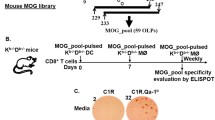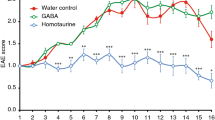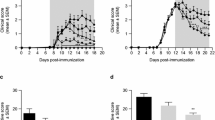Abstract
Increasing evidence suggests that in addition to T cell-dependent effector mechanisms, autoantibodies are also involved in the pathogenesis of MS, including demyelinating antibodies specific for myelin oligodendrocyte glycoprotein (MOG). Our previous studies have demonstrated that recombinant T cell receptor ligands (RTLs) are very effective for treating T cell-mediated experimental autoimmune encephalomyelitis (EAE). In order to expand the scope of RTL therapy in MS patients, it was of interest to study RTL treatment of EAE involving a demyelinating antibody component. Therefore, we evaluated the therapeutic effects of RTL551, specific for T cells reactive to mouse (m)MOG-35-55 peptide, on EAE induced with recombinant human (rh)MOG in C57BL/6 mice. We report that RTL551 therapy can reverse disease progression and reduce demyelination and axonal damage induced by rhMOG without suppressing the anti-MOG antibody response. This result suggests that T cell-mediated inflammation and associated blood–brain barrier dysfunction are the central contributors to EAE pathogenesis and that successful regulation of these key players restricts potential damage by demyelinating antibodies. The results of our study lend support for the use of RTL therapy for treatment of MS subjects whose disease includes inflammatory T cells as well as those with an additional antibody component.






Similar content being viewed by others
References
Bruck W, Lucchinetti C, Lassmann H (2002) The pathology of primary progressive multiple sclerosis. Mult Scler 8:93–97
Burrows GG, Bebo BF Jr, Adlard KL, Vandenbark AA, Offner H (1998) Two-domain MHC class II molecules form stable complexes with myelin basic protein 69-89 peptide that detect and inhibit rat encephalitogenic T cells and treat experimental autoimmune encephalomyelitis. J Immunol 161:5987–5996
Burrows GG, Chou YK, Wang C, Chang JW, Finn TP, Culbertson NE, Kim J, Bourdette DN, Lewinsohn DA, Lewinsohn DM, Ikeda M, Yoshioka T, Allen CN, Offner H, Vandenbark AA (2001) Rudimentary TCR signaling triggers default IL-10 secretion by human Th1 cells. J Immunol 167:4386–4395
Chan J, Ban EJ, Chun KH, Wang S, McQualter J, Bernard C, Toh BH, Alderuccio F (2008) Methylprednisolone induces reversible clinical and pathological remission and loss of lymphocyte reactivity to myelin oligodendrocyte glycoprotein in experimental autoimmune encephalomyelitis. Autoimmunity 41:405–413
Chang JW, Mechling DE, Bachinger HP, Burrows GG (2001) Design, engineering, and production of human recombinant T cell receptor ligands derived from human leukocyte antigen DR2. J Biol Chem 276:24170–24176
Chou YK, Culbertson N, Rich C, LaTocha D, Buenafe AC, Huan J, Link J, Wands JM, Born WK, Offner H, Bourdette DN, Burrows GG, Vandenbark AA (2004) T-cell hybridoma specific for myelin oligodendrocyte glycoprotein-35-55 peptide produced from HLA-DRB1*1501-transgenic mice. J Neurosci Res 77:670–680
Haines JL et al (1996) A complete genomic screen for multiple sclerosis underscores a role for the major histocompatability complex. The Multiple Sclerosis Genetics Group. Nat Genet 13:469–471
Hauser SL (2008) Multiple lessons for multiple sclerosis. N Engl J Med 359:1838–1841
Huan J, Subramanian S, Jones R, Rich C, Link J, Mooney J, Bourdette DN, Vandenbark AA, Burrows GG, Offner H (2004) Monomeric recombinant TCR ligand reduces relapse rate and severity of experimental autoimmune encephalomyelitis in SJL/J mice through cytokine switch. J Immunol 172:4556–4566
Kieseier BC, Hartung HP (2003) Current disease-modifying therapies in multiple sclerosis. Semin Neurol 23:133–146
Lyons JA, Ramsbottom MJ, Cross AH (2002) Critical role of antigen-specific antibody in experimental autoimmune encephalomyelitis induced by recombinant myelin oligodendrocyte glycoprotein. Eur J Immunol 32:1905–1913
Marta CB, Oliver AR, Sweet RA, Pfeiffer SE, Ruddle NH (2005) Pathogenic myelin oligodendrocyte glycoprotein antibodies recognize glycosylated epitopes and perturb oligodendrocyte physiology. Proc Natl Acad Sci U S A 102:13992–13997
Merkler D, Schmelting B, Czeh B, Fuchs E, Stadelmann C, Bruck W (2006) Myelin oligodendrocyte glycoprotein-induced experimental autoimmune encephalomyelitis in the common marmoset reflects the immunopathology of pattern II multiple sclerosis lesions. Mult Scler 12:369–374
O'Connor KC et al (2007) Self-antigen tetramers discriminate between myelin autoantibodies to native or denatured protein. Nat Med 13:211–217
Oliver AR, Lyon GM, Ruddle NH (2003) Rat and human myelin oligodendrocyte glycoproteins induce experimental autoimmune encephalomyelitis by different mechanisms in C57BL/6 mice. J Immunol 171:462–468
Pollinger B, Krishnamoorthy G, Berer K, Lassmann H, Bosl MR, Dunn R, Domingues HS, Holz A, Kurschus FC, Wekerle H (2009) Spontaneous relapsing-remitting EAE in the SJL/J mouse: MOG-reactive transgenic T cells recruit endogenous MOG-specific B cells. J Exp Med. doi:jem.20090299
Sinha S, Subramanian S, Proctor TM, Kaler LJ, Grafe M, Dahan R, Huan J, Vandenbark AA, Burrows GG, Offner H (2007) A promising therapeutic approach for multiple sclerosis: recombinant T-cell receptor ligands modulate experimental autoimmune encephalomyelitis by reducing interleukin-17 production and inhibiting migration of encephalitogenic cells into the CNS. J Neurosci 27:12531–12539
Sinha S, Subramanian S, Miller L, Proctor TM, Roberts C, Burrows GG, Vandenbark AA, Offner H (2009) Cytokine switch and bystander suppression of autoimmune responses to multiple antigens in experimental autoimmune encephalomyelitis by a single recombinant T-cell receptor ligand. J Neurosci 29:3816–3823
Storch M, Lassmann H (1997) Pathology and pathogenesis of demyelinating diseases. Curr Opin Neurol 10:1838–1841
Vandenbark AA, Rich C, Mooney J, Zamora A, Wang C, Huan J, Fugger L, Offner H, Jones R, Burrows GG (2003) Recombinant TCR ligand induces tolerance to myelin oligodendrocyte glycoprotein 35-55 peptide and reverses clinical and histological signs of chronic experimental autoimmune encephalomyelitis in HLA-DR2 transgenic mice. J Immunol 171:127–133
Wang C, Mooney JL, Meza-Romero R, Chou YK, Huan J, Vandenbark AA, Offner H, Burrows GG (2003) Recombinant TCR ligand induces early TCR signaling and a unique pattern of downstream activation. J Immunol 171:1934–1940
Wang C, Gold BG, Kaler LJ, Yu X, Afentoulis ME, Burrows GG, Vandenbark AA, Bourdette DN, Offner H (2006) Antigen-specific therapy promotes repair of myelin and axonal damage in established EAE. J Neurochem 98:1817–1827
Acknowledgments
The authors wish to thank Ms. Eva K. Niehaus for assistance in manuscript preparation. Dr. Sinha is a Postdoctoral Fellow of the National Multiple Sclerosis Society, and this work was supported in part by National Multiple Sclerosis Society Postdoctoral Fellowship FG1749-A-1 and National Multiple Sclerosis Society grants RG3794-A-4, RG3468, and RG3844A2/1; Multiple Sclerosis Society grant 874/07; National Institutes of Health grants NS47661, AI43960, and NS46877; The Nancy Davis Center Without Walls; The Biomedical Laboratory R&D Service, Department of Veterans Affairs; The National Health and Medical Research Council of Australia, The Baker Foundation; and the Bellberry Ltd Fund.
Conflict of interest
Drs. Burrows, Offner, Vandenbark, and OHSU have a significant financial interest in Artielle ImmunoTherapeutics, Inc., a company that may have a commercial interest in the results of this research and technology. This potential conflict of interest has been reviewed and managed by the OHSU and VAMC Conflict of Interest in Research Committees.
Author information
Authors and Affiliations
Corresponding author
Rights and permissions
About this article
Cite this article
Sinha, S., Subramanian, S., Emerson-Webber, A. et al. Recombinant TCR Ligand Reverses Clinical Signs and CNS Damage of EAE Induced by Recombinant Human MOG. J Neuroimmune Pharmacol 5, 231–239 (2010). https://doi.org/10.1007/s11481-009-9175-1
Received:
Accepted:
Published:
Issue Date:
DOI: https://doi.org/10.1007/s11481-009-9175-1




